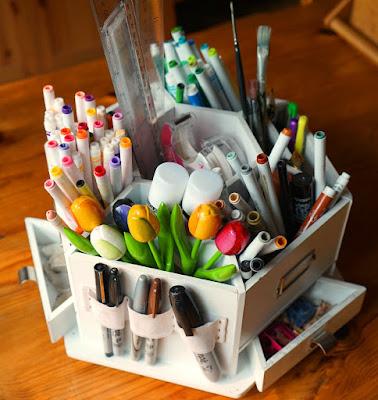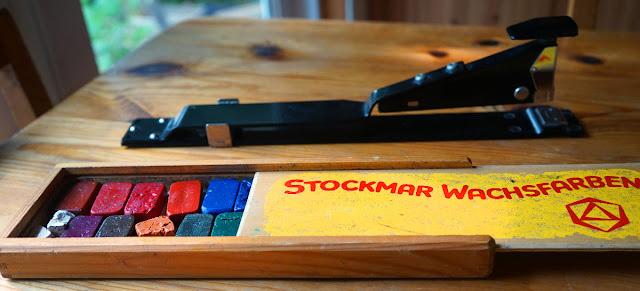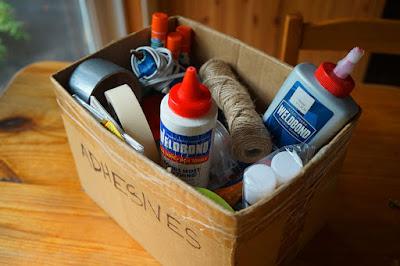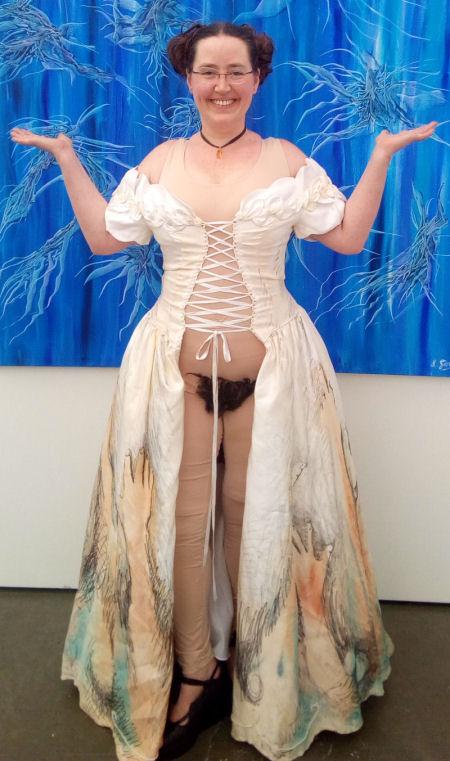
When I was in high school there was a poster on the door of my art classroom that displayed the then-ubiquitous 3 R’s (Reading, wRiting, and ‘Rithmatic) along with a 4th: aRt. I think Mrs Sunday never knew how much that poster influenced my life. In grade twelve I spent nearly every lunch hour in the corner of the art room, using up her acrylic supply for finger-painting, and paint-squirting. To her enormous credit, she let me do it. I still do it, and I encourage everyone to do it – to get as messy and unexpectedly creative as possible with whatever supplies they’re given.
I spend a lot of time on my other blog talking about explorative wilderness play, but many readers know I’m also an artist and art educator, so I am often asked about “real” art supplies, and what kinds of simple art projects are good for various situations. I feel like it’s time I give a nice solid answer to that.
First, let me be clear: The best way to learn art is by exploration. Art is also a wonderful explorative activity for learning everything else. The Council of Ministers of Education, Canada (2012) states the following:
“The benefits of play are recognized by the scientific community. There is now evidence that neural pathways in children’s brains are influenced and advanced in their development through exploration, thinking skills, problem solving, and language expression that occur during play.
“Research also demonstrates that play-based learning leads to greater social, emotional, and academic success. Based on such evidence, ministers of education endorse a sustainable pedagogy for the future that does not separate play from learning but brings them together to promote creativity in future generations. In fact, play is considered to be so essential to healthy development that the United Nations has recognized it as a specific right for all children.”
So all those wonderful prescriptive art projects where you know the outcome before you begin, and the process of creation means following instructions? Those awesome craft kits that come with the pictures of what it will look like when you’re done? They’re junk. Throw them away. Or at the very least, get rid of the packaging and present the included materials with no expectations or directions and let the kids do whatever they want with them. Yes little ones might eat the crayons. So make sure they’re non-toxic. Older kids might also melt them to make candles or wax prints or just to see how cool the melted colours are when pouring them around. Awesome! All of these things are actually done by professional artists all the time, so it’s not even a stretch of the imagination to see their value. In fact, a stretch of the imagination is exactly where the value is to be found – because that is where the learning is. When I apply for an art grant for my own artistic practice, it always includes funding for “research”… which in the art world means experimentation and playing with material, form, and method.
It’s important to think about how the presentation of the materials influences the way we use them. My father used to own a toy store, and supplied the Waldorf school in North Vancouver with the wonderful beeswax block crayons they use. He always had a lot of blacks left over, because they don’t use those in their program. How does a child’s thought-process change if they are never presented with the option to colour with black? We can’t know for sure, but I am positive there are some interesting associations, there. I give me children all the colours. But do I always present them in rainbow-gradient? No. And amazingly, the kids end up sorting them themselves, into a myriad of different patterns, either because the sorting itself is fun, or because it’s useful for whatever they’re doing with the crayons. This, too, is an important part of their learning. It’s how they familiarize themselves with the materials they’re using, and with the colours they’re working with.
Now for some material suggestions. I’m going to go most often with the cheapest alternatives, because we live in a disastrously consumerist society, and none of us needs to be buying new materials when they’re not essential. Even on a tight budget you can get a load of materials at huge stores, but you don’t need to. Going with unexpected chance finds from the local thrift shop, recycling depot, or other people’s refuse not only saves money but also opens all sorts of new avenues for experimentation and problem-solving that will teach your kids more than a pristine new package from a store will.
Art-making space: Whatever your circumstances, just make sure you provide a large area where mess-making is acceptable and clean-up is easy. A large table is great but if you don’t have one, or don’t have suitable chairs, a corner of washable floor can be great too. Outside, a sheet of plywood on the ground suffices. I’ve done this often. Cover the space with a heavy paper that can be used for mess-making, drawing, or notes, and replaced when necessary. You can also cover it with a heavy plastic table-cloth, but glues and acrylics will eventually make the plastic lumpy, so I still recommend the paper-cover on top to make cleanup easier.
But… don’t keep art confined to this space. Take it to the kitchen. Bake cookies and cakes and decorate those; fill the sink with water and drip paints in or use the surface for oil-resist prints. Take art outside. Do tie-dyeing or papier mache there. Paint the lawn; paint your car or bicycle or front door. My uncle once gave his young children house paints and had them hand- and foot-print the front entry room. Decades later, their beautiful creative creation is still the welcome that guests first receive. Make everywhere art space.
An Easel: Not only does it give a new perspective to have your workspace upright, but dripping paint is wonderful, and should be encouraged. However, you don’t have to go get an expensive easel. A stable propped board will do, as will an old sandwich board on a table. The best accessory for your easel, though, is a pair (or more) of large bulldog clips to hold paper in place.

Storage: If you want to have a beautiful art corner, you still can, even if it’s not colour-coordinated or tidy. A bunch of large bins and a very few smaller ones will do well, or similarly a chest of drawers. We do have a great art-storage carousel that has been in use in our house for many years, holding an assortment of whatever the currently-most-used supplies are. This makes a greater number of supplies more easily accessible to various people seated at a table, and a handy place to put them away quickly. But it’s not essential. A bunch of materials rolling around the table can actually inspire new ideas.
Some kind of drying rack is a great idea. We never had space for one, but the end of our dining room table was usually used for drying. Still, if you have space, old oven racks or baking racks can be a great thing to have in your art area. A permanent set of wire-rack shelves is amazing.
Paper: It really doesn’t matter what you have – just have some. Preferably lots. We commonly have whatever papers people have passed on to us, including old letterheads, those old perforated printer-papers, construction and manila papers, some old used sketchbooks that people threw away with 80% of their pages still unused, and various types of white and coloured printer papers. I also supply my kids with the seemingly endless supply of graph-paper which they love. No papers have specific intentions. It’s OK with me if fancy sketchbook papers get used for note-taking or construction or torn-up little shreds of I-don’t-know-what, or even crumpling into balls and called ‘cat toys’. Getting the paper second-hand helps me let go of my own hang-ups about ‘intended use’ and ‘value’, which gives the kids a broader explorative environment, and greater learning opportunities.
Cardboard: You could go all out and have some gigantic boxes for construction experimentation (my kids have built cars, rocket-ships, stores and villages, and most recently, as teens, a vending machine which they took into public for entertainment). But at the very least you should have some old boxes or scraps around in case construction starts happening. I hope it does!
Cutting Devices: Good scissors, appropriately sized for the people using them. An exacto knife. Obviously not for young ones, but you might have one handy to help out with big cuts. And a serrated bread knife! This has been very helpful to us for cutting cardboard, especially. Also never underestimate the usefulness of a good hole-pucher, and things like skewers for poking holes in cardboard.
String, ribbon, and other tying materials: Especially for constructing with cardboard, but also comes in handy for making books and all manner of other things. You never know when this will be just the thing you need in the moment!

And take a look at this Stockmar box from my childhood. The box has been replenished piece by piece over the years, and the crayons have been chewed and used by multiple generations.
Mark-Making: It’s important not to narrow our kids’ ideas of what constitutes a proper mark. So much is lost to a narrow mind! So provide lots of different options, and let the kids mix them up. You might want to keep some expensive felt-pens out of the acrylics, just to keep them in working condition, but experimental mixing of media in general is a highly educational activity, so do it! You don’t need all of these but at least have many.
- chisel-tipped pens – for older kids sharpies are awesome.
- a great assortment of colourful felt-pens. Those cute stubby pens are a huge waste of plastic, though, since they run out frustratingly quickly and have to be thrown away. Tip: Store felt and ink pens tip-down, which means they last longer before drying out.
- pencil crayons (as they are worn down they make many different types of marks)
- wax crayons. Lots – and be prepared to see them very, very broken.
- those Stockmar beeswax block crayons I mentioned earlier.
- paint pucks that fit into a plastic tray – when you don’t have time to get out the bottled paints, or just for watery experimentation, these are a wonderful thing to have available.
- bottles of tempera or acrylic paints that you can squirt out small amounts of for open-ended free painting (tempera is great for younger kids who might ingest it, but acrylic is great for the ability to paint on many surfaces).
- brushes! The best in my experience are natural stiff-bristle brushes, flat or chisel-shaped, because they give more opportunity for a variety of marks than round ones do, but others can be fun too.
- pencils, erasers, and fine black markers.
- something smudgy like chalk or oil pastels. Sidewalk chalk can be used inside and chalkboard chalk can be used outside.

Glue sticks: Glue gets two sections because you need both. We always have a few glue sticks around, as they’re the best way to stick papers together without soaking or wrinkling them. I recommend acid-free strong-hold glue-sticks. Don’t bother with those silly school-glue types. They often don’t hold.
White glue: While basic white glue will work for many applications, such as stiffening fabrics, gluing together cardboards, fabrics and layers of paper, we keep a bottle of Weldbond universal adhesive around because it glues almost everything! That’s a great advantage when you’re mixing up sometimes unexpected materials.
Fabric scraps and found materials: Without getting into the wonderful worlds of sewing and yarn arts, fabric itself is indispensable as an explorative material. With a bin of such materials for free creativity and exploration, you can create costumes, forts, decorations for those cardboard constructions, head-dresses, jewelry, dolls, doll-clothes, and really an endless list of delights. Have a bin of scrap fabric! And to this add found materials like plastic, corks, sticks, wires, etc. You never know what random things will be fabulous. Discarded CD’s and cutlery for example. You just never know.
Something to squish and build with: A great block of clay and a big clay board to work on is awesome. That would be my favourite, although to be honest I didn’t often have it on hand for my kids. We mostly used natural clay from the creek outside, and mud. Of course there are plenty of polymer clays available and while they’re fun for building with, I don’t personally like the environmental burden they bear (wanton use of plastics that end up in the garbage). I’m not really suggesting slime, either, because while slime-making and playing is a fine explorative activity, and fun, I think we get so much more mileage out of materials that stay put when shaped. A biodegradable glue mixed with sawdust or ground/shredded newspaper, by the way, is a pretty cool modelling material. So is salt dough, and gingerbread, if you want to eat your creation. One brand name product my kids did love and use for a long time was Stockmar modelling beeswax (no I’m not paid by Stockmar; they just make a few really fabulous products!).
***
So you see, the main thing is to have a fabulously free space and some stuff to play with there. Get messy. Play with the kids (or teens or adults!). They will learn a huge amount from watching what you do, so make sure you’re exploring and have no idea what your outcome will be. This will help them learn to do the same, and together you’ll make wonderful discoveries.
Originally published in August, 2018

